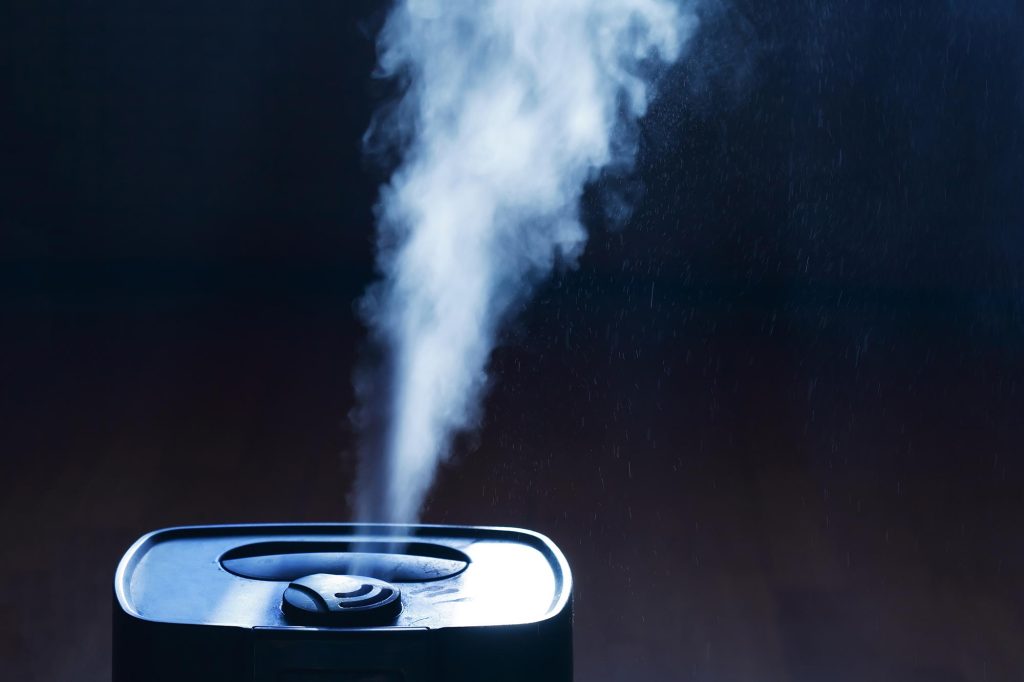
أظهرت دراسة أجراها معهد ماساتشوستس للتكنولوجيا أن الحفاظ على الرطوبة في الأماكن المغلقة في مكان جيد قد يقلل من انتشار COVID-19.
يربط بحث جديد بين البيئات الداخلية الجافة جدًا والرطبة جدًا مع الأسوأ[{” attribute=””>COVID-19 outcomes.
We know proper indoor ventilation is key to reducing the spread of COVID-19. Now, a study by MIT researchers finds that indoor relative humidity may also influence the transmission of the virus.
Relative humidity is the amount of moisture in the air compared to the total moisture the air can hold at a given temperature before saturating and forming condensation.
In a study published in the Journal of the Royal Society Interface on November 16, the MIT team reports that maintaining an indoor relative humidity between 40 and 60 percent is associated with relatively lower rates of COVID-19 infections and deaths, while indoor conditions outside this range are associated with worse COVID-19 outcomes. To put this into perspective, most people are comfortable between 30 and 50 percent relative humidity, and an airplane cabin is at around 20 percent relative humidity.
The findings are based on the team’s analysis of COVID-19 data combined with meteorological measurements from 121 countries, from January 2020 through August 2020. Their study suggests a strong connection between regional outbreaks and indoor relative humidity.
In general, the researchers found that whenever a region experienced a rise in COVID-19 cases and deaths prevaccination, the estimated indoor relative humidity in that region, on average, was either lower than 40 percent or higher than 60 percent regardless of season. Nearly all regions in the study experienced fewer COVID-19 cases and deaths during periods when estimated indoor relative humidity was within a “sweet spot” between 40 and 60 percent.
“There’s potentially a protective effect of this intermediate indoor relative humidity,” suggests lead author Connor Verheyen, a PhD student in medical engineering and medical physics in the Harvard-MIT Program in Health Sciences and Technology.
“Indoor ventilation is still critical,” says co-author Lydia Bourouiba, director of the MIT Fluid Dynamics of Disease Transmission Laboratory and associate professor in the departments of Civil and Environmental Engineering and Mechanical Engineering, and at the Institute for Medical Engineering and Science at MIT. “However, we find that maintaining an indoor relative humidity in that sweet spot — of 40 to 60 percent — is associated with reduced COVID-19 cases and deaths.”
Seasonal swing?
Since the start of the COVID-19 pandemic, scientists have considered the possibility that the virus’ virulence swings with the seasons. Infections and associated deaths appear to rise in winter and ebb in summer. But studies looking to link the virus’ patterns to seasonal outdoor conditions have yielded mixed results.
Verheyen and Bourouiba examined whether COVID-19 is influenced instead by indoor — rather than outdoor — conditions, and, specifically, relative humidity. After all, they note that most societies spend more than 90 percent of their time indoors, where the majority of viral transmission has been shown to occur. What’s more, indoor conditions can be quite different from outdoor conditions as a result of climate control systems, such as heaters that significantly dry out indoor air.
Could indoor relative humidity have affected the spread and severity of COVID-19 around the world? And could it help explain the differences in health outcomes from region to region?
Tracking humidity
For answers, the team focused on the early period of the pandemic when vaccines were not yet available, reasoning that vaccinated populations would obscure the influence of any other factor such as indoor humidity. They gathered global COVID-19 data, including case counts and reported deaths, from January 2020 to August 2020, and identified countries with at least 50 deaths, indicating at least one outbreak had occurred in those countries.
In all, they focused on 121 countries where COVID-19 outbreaks occurred. For each country, they also tracked the local COVID-19 related policies, such as isolation, quarantine, and testing measures, and their statistical association with COVID-19 outcomes.
For each day that COVID-19 data was available, they used meteorological data to calculate a country’s outdoor relative humidity. They then estimated the average indoor relative humidity, based on outdoor relative humidity and guidelines on temperature ranges for human comfort. For instance, guidelines report that humans are comfortable between 66 to 77 degrees Fahrenheit indoors. They also assumed that on average, most populations have the means to heat indoor spaces to comfortable temperatures. Finally, they also collected experimental data, which they used to validate their estimation approach.
For every instance when outdoor temperatures were below the typical human comfort range, they assumed indoor spaces were heated to reach that comfort range. Based on the added heating, they calculated the associated drop in indoor relative humidity.
In warmer times, both outdoor and indoor relative humidity for each country was about the same, but they quickly diverged in colder times. While outdoor humidity remained around 50 percent throughout the year, indoor relative humidity for countries in the Northern and Southern Hemispheres dropped below 40 percent in their respective colder periods, when COVID-19 cases and deaths also spiked in these regions.
For countries in the tropics, relative humidity was about the same indoors and outdoors throughout the year, with a gradual rise indoors during the region’s summer season, when high outdoor humidity likely raised the indoor relative humidity over 60 percent. They found this rise mirrored the gradual increase in COVID-19 deaths in the tropics.
“We saw more reported COVID-19 deaths on the low and high end of indoor relative humidity, and less in this sweet spot of 40 to 60 percent,” Verheyen says. “This intermediate relative humidity window is associated with a better outcome, meaning fewer deaths and a deceleration of the pandemic.”
“We were very skeptical initially, especially as the COVID-19 data can be noisy and inconsistent,” Bourouiba says. “We thus were very thorough trying to poke holes in our own analysis, using a range of approaches to test the limits and robustness of the findings, including taking into account factors such as government intervention. Despite all our best efforts, we found that even when considering countries with very strong versus very weak COVID-19 mitigation policies, or wildly different outdoor conditions, indoor — rather than outdoor — relative humidity maintains an underlying strong and robust link with COVID-19 outcomes.”
It’s still unclear how indoor relative humidity affects COVID-19 outcomes. The team’s follow-up studies suggest that pathogens may survive longer in respiratory droplets in both very dry and very humid conditions.
“Our ongoing work shows that there are emerging hints of mechanistic links between these factors,” Bourouiba says. “For now, however, we can say that indoor relative humidity emerges in a robust manner as another mitigation lever that organizations and individuals can monitor, adjust, and maintain in the optimal 40 to 60 percent range, in addition to proper ventilation.”
Reference: “Associations between indoor relative humidity and global COVID-19 outcomes” by C. A. Verheyen and L. Bourouiba, 16 November 2022, Journal of The Royal Society Interface.
DOI: 10.1098/rsif.2021.0865
This research was made possible, in part, by an MIT Alumni Class fund, the Richard and Susan Smith Family Foundation, the National Institutes of Health, and the National Science Foundation.

“مدمن ثقافة البوب. عشاق التلفزيون. نينجا الكحول. إجمالي مهووس البيرة. خبير تويتر محترف.”


:max_bytes(150000):strip_icc():focal(749x0:751x2)/Shohei-Ohtani-dog-first-pitch-tout-1-082924jpg-953710b5907e41dfa6827ec1c99cf28b.jpg)
/cdn.vox-cdn.com/uploads/chorus_asset/file/25594197/Genki_TurboCharger_Hero.jpg)



More Stories
المفتش العام لوكالة ناسا يصدر تقريرا قاسيا بشأن تأخير مشروع إطلاق المركبة الفضائية SLS
كيف أصبحت الثقوب السوداء بهذا الحجم والسرعة؟ الإجابة تكمن في الظلام
طالبة من جامعة نورث كارولينا ستصبح أصغر امرأة تعبر حدود الفضاء على متن بلو أوريجين